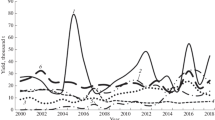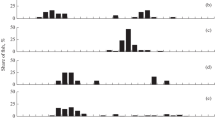Abstract
Based on the size composition of freshwater bream Abramis brama in commercial catches from the Ural River, we have assessed the stock status of the Ural stock of the North Caspian population using the LB-SPR method. Values of the parameters of the Bertalanffy equation have been calculated for the bream from the Ural stock for the first time: the asymptotic length of an individual is 47.0 cm, the growth constant is 0.13, the hypothetical age at which the fish length would be 0 is 2.17; 50% of individuals mature at a length of 23.2 cm and 95% at a length of 28.7 cm. The estimated spawning potential ratio (0.26) is lower than the biological target (0.40) and formally indicates the state of stock overfishing.








Similar content being viewed by others
REFERENCES
Babayan, V.K., Bobyrev, A.E., Bulgakova, T.I., et al., Metodicheskie rekomendatsii po otsenke zapasov prioritetnykh vidov vodnykh biologicheskikh resursov (Methodological Recommendations for Assessment of Resources of Priority Species of Aquatic Biological Resources), Moscow: VNIRO, 2018.
Bertalanffy, L., Basic concepts in quantitative biology of metabolism, Helgol. Wiss. Meeresunters., 1964, vol. 9, pp. 5–37. https://doi.org/10.1007/BF01610024
Brooks, E.N., Powers, J.E., and Cortés, E., Analytical reference points for age-structured models: application to data-poor fisheries, ICES J. Mar. Sci., 2010, vol. 67, no. 1, pp. 165–175. https://doi.org/10.1093/icesjms/fsp225
Choat, J.H. and Robertson, D.R., Age-based studies on coral reef fishes, in Coral Reef Fishes: Dynamics and Diversity in a Complex Ecosystem, Sale, P.F., Ed., San Diego: Academic, 2002, pp. 57–80.
Choat, J., Axe, L., and Lou, D., Growth and longevity in fishes of the family Scaridae, Mar. Ecol.: Progr. Ser., 1996, vol. 145, pp. 33–41. https://doi.org/10.3354/meps145033
Chugunova, N.I., Rukovodstvo po izucheniyu vozrasta i rosta ryb (Guide for the Study of Age and Growth of Fishes), Moscow: Akad. Nauk SSSR, 1959.
Clark, W.G.W., F 35% revisited ten years later, N. Am. J. Fish. Manage., 2002, vol. 22, pp. 251–257. https://doi.org/10.1577/1548-8675(2002)022<0251:FRTYL>2.0.CO;2
Coulson, P.G., Potter, I.C., and Hall, N.G., The biological characteristics of Scorpis aequipinnis (Kyphosidae) including relevant comparisons with those of other species and particularly of a heavily exploited congener, Fish. Res., 2012, vols. 125–126, pp. 272–282. https://doi.org/10.1016/j.fishres.2012.02.031
FishBase, Version 12/2019, Froese R. and Pauly D., Eds., 2019. https://www.fishbase.org.
Gerritsen, H.D. and McGrath, D., Precision estimates and suggested sample sizes for length-frequency data, Fish. Bull., 2007, vol. 106, pp. 116–120.
Goodyear, C.P. Spawning stock biomass per recruit in fisheries management: foundation and current use, Can. Spec. Publ. Fish. Aquat. Sci., 1993, vol. 120, pp. 67–81.
Haddon, M.J., Modelling and Quantitative Methods in Fisheries, New York: Chapman and Hall, 2011. https://doi.org/10.1201/9781439894170
Hewitt, D.A. and Hoenig, J.M., Comparison of two approaches for estimating natural mortality based on longevity, Fish. Bull., 2005, vol. 103, pp. 433–437.
Hordyk, A.R., LBSPR: length-based spawning potential ratio, R package version 0.1.5. https://CRAN.R-project.org/ package=LBSPR. 2019.
Hordyk, A.R., Ono, K., Sainsbury, K.J., et al., Some explorations of the life history ratios to describe length composition, spawning-per-recruit, and the spawning potential ratio, ICES J. Mar. Sci., 2015a, vol. 72, no. 1, pp. 204–216. https://doi.org/10.1093/icesjms/fst235
Hordyk, A.R., Ono, K., Valencia, S.R., et al., A novel length-based empirical estimation method of spawning potential ratio (SPR), and tests of its performance, for small-scale, data-poor fisheries, ICES J. Mar. Sci., 2015b, vol. 72, no. 1, pp. 217–231. https://doi.org/10.1093/icesjms/fsu004
Jensen, A.L., Beverton and Holt life history invariants result from optimal trade-off of reproduction and survival, Can. J. Fish. Aquat. Sci., 1996, vol. 53, pp. 820–822. https://doi.org/10.1139/f95-233
Kuz’menko, S.V., Fishery and qualitative characteristics of the bream from the Ural River, Materialy I Vserosssiiskoi konfrentsii “Sovremennoe sostoyanie bioresursov vnutrennikh vodoemov” (Proc. I All-Russ. Conf. “Modern State of Biological Resources of Inland Reservoirs”), Moscow: Akvaros, 2011, vol. 1, pp. 448–453.
Levashina, N.V., Specific distribution of bream Abramis brama (Linnaeus, 1758) in the northern part of the Caspian Sea in the present, Estestv. Nauki, 2013, no. 3, pp. 33–51.
Levashina, N.V., Population development of the bream Abramis brama (Linnaeus, 1758) and its commercial use in the Volga-Caspian basin, Extended Abstract of Cand. Sci. (Biol.) Dissertation, Astrakhan: Astrakhan State Tech. Univ., 2020.
Levashina, N.V. and Popov, N.N., Modern commercial and biological characteristics of the bream Abramis brama in the Volga and Ural rivers, Vopr. Rybolov., 2012, vol. 13, no. 4 (52), pp. 805–819.
Mace, P. and Sissenwine, M., How much spawning is enough? Risk evaluation and biological reference points for fisheries management, Can. Spec. Publ. Fish. Aquat. Sci., 1993, vol. 120, pp. 101–118.
Maceina, M.J. and Pereira, D.L., Recruitment, in Analysis and Interpretation of Freshwater Fisheries Data, Guy, C.S. and Brown, M.L., Eds., Bethesda, MD: Am. Fish. Soc., 2007, pp. 121–185. https://doi.org/10.47886/9781888569773.ch4
Mitrofanov, V.P., Dukravets, G.M., Mel’nikov, V.A., et al., Ryby Kazakhstana. Tom 3. Karpovye (Fishes of Kazakhstan, Vol. 3: Cyprinidae Fishes), Alma-Ata: Nauka, 1988.
Ogle, D.H., FishR vignette—maturity schedules. 2013. https://www.derekogle.com/fishR/examples/oldFishRVignettes/Maturity.pdf.
Ogle, D.H., Introductory Fisheries Analyses with R, Boca Raton, FL: CRC Press, 2016. https://doi.org/10.1201/9781315371986.
Ogle, D.H., Wheeler, P., and Dinno, A., FSA: fisheries stock analysis, R package version, 2021. https://github.com/ droglenc/FSA.
Petukhova, N.G., Preliminary assessment of the stock status of Atlantic bonito (Sarda sarda) in the northeastern part of the Atlantic Ocean, J. Ichthyol., 2020, vol. 60, no. 5, pp. 732–741. https://doi.org/10.1134/S0032945220050069
Pravdin, I.F., Rukovodstvo po izucheniyu ryb (Guide for Study of Fishes), Moscow: Pishchevaya Prom-st’, 1966.
Prince, J.D., Hordyk, A.R., Valencia, S.R., et al., Revisiting the concept of Beverton–Holt life-history invariants with the aim of informing data-poor fisheries assessment, ICES J. Mar. Sci., 2015a, vol. 72, no. 1, pp. 194– 203. https://doi.org/10.1093/icesjms/fsu011
Prince, J. D., Victor, S., Kloulchad, V., et al., Length based SPR assessment of eleven Indo-Pacific coral reef fish populations in Palau, Fish. Res., 2015b, vol. 171, pp. 42–58. https://doi.org/10.1016/j.fishres.2017.12.012
Prince, J.D., Lalavanua, W., Tamanitoakula, J., et al., Spawning potential surveys reveal an urgent need for effective management, Fish. Newslett., 2019, vol. 158, pp. 28–36.
Restrepo, V. and Powers, J., Precautionary control rules in US fisheries management: specification and performance, ICES J. Mar. Sci., 1999, vol. 56, pp. 846–852.
Rikhter, V.A. and Efanov, V.N., An approach to evaluation of natural mortality of fish populations, Tr. Atl. Nauchno-Issled. Inst. Rybn. Khoz. Okeanogr., 1977, no. 73, pp. 75–77.
Roff, D.A., The evolution of life history parameters in teleosts, Can. J. Fish. Aquat. Sci., 1984, vol. 41, pp. 989–1000.
Shibaev, S.V., Golubkova, T.A., and Ryabchun, V.A., Cohort analysis of population dynamics of the common bream (Abramis brama L.) in the Vistula (Kaliningrad) Bay of the Baltic Sea, Izv. Kaliningrad. Gos. Tekh. Univ., 2012, no. 24, pp. 95–102.
Sudakov, G.A., Vlasenko, A.D., Khodorevskaya R.P., et al., Instruktsii po sboru i pervichnoi obrabotke materialov vodnykh bioresursov Kaspiiskogo basseina i sredy ikh obitaniya (Instructions for Sampling and Primary Processing of Materials of Aquatic Bioresources from the Caspian Basin and Their Environment), Astrakhan: Kasp. Nauchno-Issled. Inst. Rybn. Khoz., 2011.
Tanasiichuk, N.P., The bream of the North Caspian Sea: distribution, change in age composition, and impact of fishing on the population composition, Tr. Kasp. Nauchno-Issled. Inst. Rybn. Khoz. Okeanogr., 1959, vol. 15, pp. 3–37.
Then, A.Y., Honeig, J.M., Hall, N.G., and Hewitt, D.A., Evaluating the predictive performance of empirical estimators of natural mortality rate using information on over 200 fish species, ICES J. Mar. Sci., 2015, vol. 72, no. 1, pp. 82–92. https://doi.org/10.1093/icesjms/fsu136
Thorson, J., FishLife: predict life history parameters for any fish, R package version 2.0.0, 2019. http://github.com/ James-Thorson/FishLife.
Thorson, J.T., Munch, S.B., Cope, J.M., and Gao, J., Predicting life history parameters for all fishes worldwide, Ecol. Appl., 2017, vol. 27, no. 8, pp. 2262–2276. http://onlinelibrary. wiley.com/doi/10.1002/eap.1606/full.
Walters, C.J. and Martell, S.J.D., Fisheries Ecology and Management, Princeton: Princeton Univ. Press, 2004.
Zhang, C.I. and Megrey, B.A., A revised Alverson and Carney model for estimating the instantaneous rate of natural mortality, Trans. Am. Fish. Soc., 2006, vol. 135, no. 3, pp. 620–633. https://doi.org/10.1577/T04-173.1
Zykov, L.A., Bioekologicheskie aspekty teorii estestvennoi smertnosti ryb (Bioecological Aspects of the Theory of Natural Mortality of Fishes), Astrakhan: Astrakhan. Gos. Univ., 2005.
ACKNOWLEDGMENTS
The authors are grateful to the developer of the LB-SPR method and LB-SPR software package A. Hordyk (Centre for Fish, Fisheries and Aquatic Ecosystems Research), as well as to N.G. Petukhova (Russian Federal Research Institute of Fishery and Oceanography) for advice on the application of the method and interpretation of the results.
Author information
Authors and Affiliations
Corresponding author
Ethics declarations
The authors declare that they have no conflict of interests.
Additional information
Translated by D. Zabolotny
Rights and permissions
About this article
Cite this article
Safaraliev, I.A., Popov, N.N. Qualitative Assessment of the Stock Status of Freshwater Bream Abramis brama (Cyprinidae) from the Ural Stock Based on the LB-SPR Method. J. Ichthyol. 62, 476–486 (2022). https://doi.org/10.1134/S0032945222030134
Received:
Revised:
Accepted:
Published:
Issue Date:
DOI: https://doi.org/10.1134/S0032945222030134




